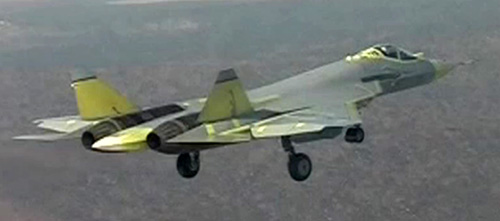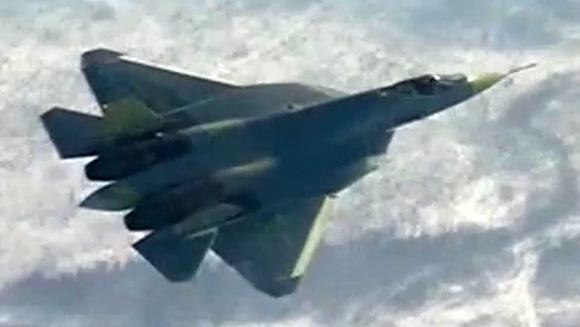In a few hours we will know the real capabilities of Russia's first fifth-generation platform. Next Monday, 20 June, the eighth prototype of Sukhoi's T-50 PAK-FA will rise in flight in final perspective configuration.
The last T-50, fully equipped with the systems envisaged in the specifications of the Ministry of Defense, could start mass production for the Russian Aerospace Forces. A second aircraft in final configuration (the ninth T-50), will fly in September.
The production plant of the Aircraft Association Komsomolsk-on-Amur in the Russian Far East hopes to start mass production by the autumn of this year, with deliveries of the first fighter stealth of Moscow in June of the 2017. There is no denying that there is much concern about the test flights that will start next Monday.
The PAK-FA updates were abruptly interrupted a few months ago due to unspecified problems. We know that in six years, the six prototypes of the T-50 have only completed 700 test flights. Despite the proclamations and an imminent series production (already postponed twice), the Russian Air Force has reduced the initial order of sixty T-50 to a dozen platforms with implemented changes. The eighth T-50 is equipped with both AESA radar and three-dimensional vector thrust control.
Right from the start, the design was considered quite sophisticated if not similar in performance to that of the F-22 Raptor. If it can be even higher this is all to prove. The Russians confirm that the Pak-Fa will be built in a number between 800 and exemplary 1000, including exports. For the T-50, an operating cycle of forty years is expected, with an estimated cost of 100 million dollars per hunt. The twelve T-50 that will be delivered to the Ministry of Defense, will be subjected to various tests before committing the government with an order of several billion dollars.
Leaving aside the real capabilities of the PAK-FA, a certain moodiness among the military begins to spread, linked to the cost of the new platform. 100 million dollars per specimen, probably 120 in the early stages of Low Rate Initial Production. There are no data on development costs incurred. Figures that must be placed in the majestic rearmament plan wanted by Putin that will end, as a first phase, in the 2020.
If for the Navy the rearmament plan is obtaining various successes (just think of the class submarines Varshavyanka), in aeronautics, the Russians are paying the inexperience with the approach of the new platforms. For example. The T-50 represents the first experience for the Russians with absorbing radar materials (RAM), compared to the thirty-year experience gained by the Americans with the F-117. Moscow, then, pays for its inexperience with fifth generation aviation technology, such as the final integration between the various sensors and the aforementioned new low observability coating.
 The T-50 took off for the first time the 29 January of 2010 (without, however, part of the avionics such as radar and arms management systems). Probably the real obstacle for the T-50 is the propulsive apparatus. The 10 June of the 2014, one of the two engines of the fifth prototype caught fire. From Sukhoi they had to suspend the production of the sixth prototype and use the components already made to repair the damaged aircraft. The seventh prototype then flew with a pair of AL-41F1, developed for Su-35 Flanker-E. It is fairly common opinion to consider valid the AL-41F1 engines for the platforms pre-stealth, like the Su-35, but not for the particular profile of a fifth-generation fighter (geometries of wings and ailerons, composite materials, coatings, etc ... etc ...).
The T-50 took off for the first time the 29 January of 2010 (without, however, part of the avionics such as radar and arms management systems). Probably the real obstacle for the T-50 is the propulsive apparatus. The 10 June of the 2014, one of the two engines of the fifth prototype caught fire. From Sukhoi they had to suspend the production of the sixth prototype and use the components already made to repair the damaged aircraft. The seventh prototype then flew with a pair of AL-41F1, developed for Su-35 Flanker-E. It is fairly common opinion to consider valid the AL-41F1 engines for the platforms pre-stealth, like the Su-35, but not for the particular profile of a fifth-generation fighter (geometries of wings and ailerons, composite materials, coatings, etc ... etc ...).
The Russian Ministry of Defense places great trust in the prototype of the new Izdeliye 30, considered the definitive engine for the T-50. Unfortunately, as confirmed by the Russian media, the development of the propulsion system will only be completed between the 2025 and the 2027. If in the naval field (the thought goes to the design of submarines Akula for example) the Russians have always been in the vanguard, aeronautical research was interrupted in the 1990, with the fall of the Soviet Union.
Propulsion is the most challenging and costly aspect of developing any aerial platform. From the reliable F119 turbofans of the F-22, for example, comes the Pratt & Whitney F135 of the F-35. The transition for what seemed like a simple evolution, did not turn out to be so natural and free of technical difficulties, still partly unsolved.
(frames: Russian Fed. MoD)












